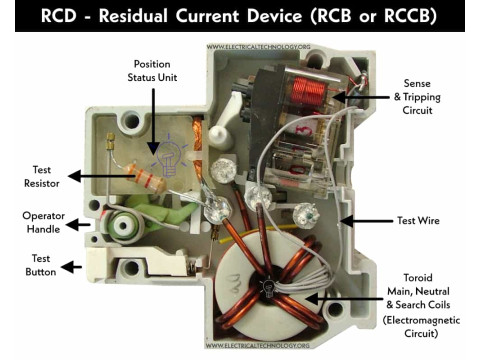Why You Need an RCD
An RCD (Residual Current Device) helps protect individuals from electric shock when they touch electrical equipment or wiring that isn’t normally energized but may become energized due to insulation faults. Beyond shock protection, certain RCDs also serve a fire prevention function.
Let’s explore how RCDs work, why they matter in both residential and commercial setups, and what types are available depending on your safety needs.
Tip: For more insights on choosing and installing RCDs (or combination breakers) in the USA, visit safsale.com, where we share detailed guides and product recommendations.
1. Primary Purpose of an RCD
The primary role of an RCD is to detect and react to leakage current—also known as differential current—that flows outside the intended electrical circuit. This leakage can happen if:
- Insulation breaks down within an appliance
- A live conductor contacts a metal casing
- A person accidentally touches a conductor carrying current
In any of these scenarios, the RCD rapidly disconnects the circuit, preventing severe injury or fatalities from electric shock.
1.1 How It Works
Inside the RCD is a differential transformer that measures the difference between incoming and outgoing current. Under normal conditions, current in the phase (hot) and neutral wires remains equal:
If a fault occurs (e.g., Ileak flows through a person or to a grounded object), the RCD detects that the incoming current no longer matches the outgoing current and instantly trips, protecting against serious shock hazards.
2. Types of RCDs by Function
One key parameter that defines an RCD is its leakage current rating—the threshold at which it trips.
2.1 Protective RCD (up to 30mA)
- Typical Rating: 10mA to 30mA
- Role: Designed primarily to safeguard people from electric shock.
- Applications: Commonly installed in homes, apartments, and locations where direct human contact with energized surfaces is most likely.
2.2 Fire-Prevention RCD (100–300mA)
- Typical Rating: 100mA to 300mA
- Role: Focuses on detecting higher leakage currents that can generate sufficient heat to start a fire.
- Applications: Often used in buildings with high risk of electrical fires, such as wood-frame houses or older facilities.
Note: While a 100mA or higher RCD can still trip if someone contacts a live part, it does not provide the same level of personal shock protection as a 30mA device. Its primary function is fire prevention.
3. Why Bother with an RCD if You Already Have a Circuit Breaker?
A standard circuit breaker protects against short circuits and overloads—currents typically measured in amps or tens of amps. It cannot detect tiny leakage currents (measured in milliamps) that can be lethal to a person.
RCDs detect these small leakage currents, making them essential for personal protection. While circuit breakers trip when currents exceed safe wire capacity, RCDs trip the moment there's an imbalance between hot and neutral, preventing shock or fire well before catastrophic damage occurs.
3.1 What About RCBOs (Difavtomats)?
An RCBO is a combined device that includes both overcurrent protection (like a circuit breaker) and leakage detection (like an RCD). It covers both shock and overload/short-circuit protection in a single module. If you’re using an RCBO, you get all the benefits of an RCD and a breaker in one package.
4. Where and Why You’d Install an RCD
4.1 Homes and Apartments
- Primary Goal: Protect against electric shock.
- Typical Setup: 30mA RCD on circuits most likely to be touched (kitchen, bathroom, outdoor).
- Fire Prevention: In standard apartments, the priority is less about wood structures catching fire and more about preventing shocks.
4.2 Private Houses (Especially Wood-Framed)
- High-Risk Construction: Wood is more flammable than concrete or steel.
- Recommended Approach: Combine 30mA RCD for personal protection with 100mA or 300mA fire-prevention RCD at the service entrance.
- Layered Protection: Lower rating RCD for individual circuits and a higher rating RCD at the main panel.
4.3 Coordination with Breakers
Because RCDs do not protect against short circuits themselves (they only detect leakage current), they must be combined with or coordinated with standard breakers or fuses—unless you use a single RCBO. This ensures:
- Overcurrent protection (breaker or fuse).
- Leakage current protection (RCD).
- Selective Coordination (when multiple RCDs or breakers are used).
5. Final Takeaways
- Primary Function: An RCD protects people from deadly electric shocks by detecting tiny leakage currents that standard breakers cannot sense.
- Secondary Function: Fire prevention RCDs (with higher trip ratings) detect leakage currents large enough to heat and ignite nearby materials.
- RCD vs. Breaker: Circuit breakers handle high overcurrents; RCDs handle small leakage currents. They each serve different protective roles.
- RCBO: A 2-in-1 device merging both functions.
- Installation: Usually in the main distribution panel, coordinated with or integrated into existing breakers. For homes with higher fire risk (e.g., wooden structures), a combination of protective and fire-prevention RCDs is recommended.
For more details about selecting the right RCD, RCBO, or other safety components, explore safsale.com. We provide expert advice on electrical safety, device ratings, and how to ensure a safe, code-compliant installation in the USA.
By understanding the differences between RCD types and why they’re needed, you can create a safer environment for yourself and your property—whether it’s a modern condo or a wood-framed home in the countryside.

